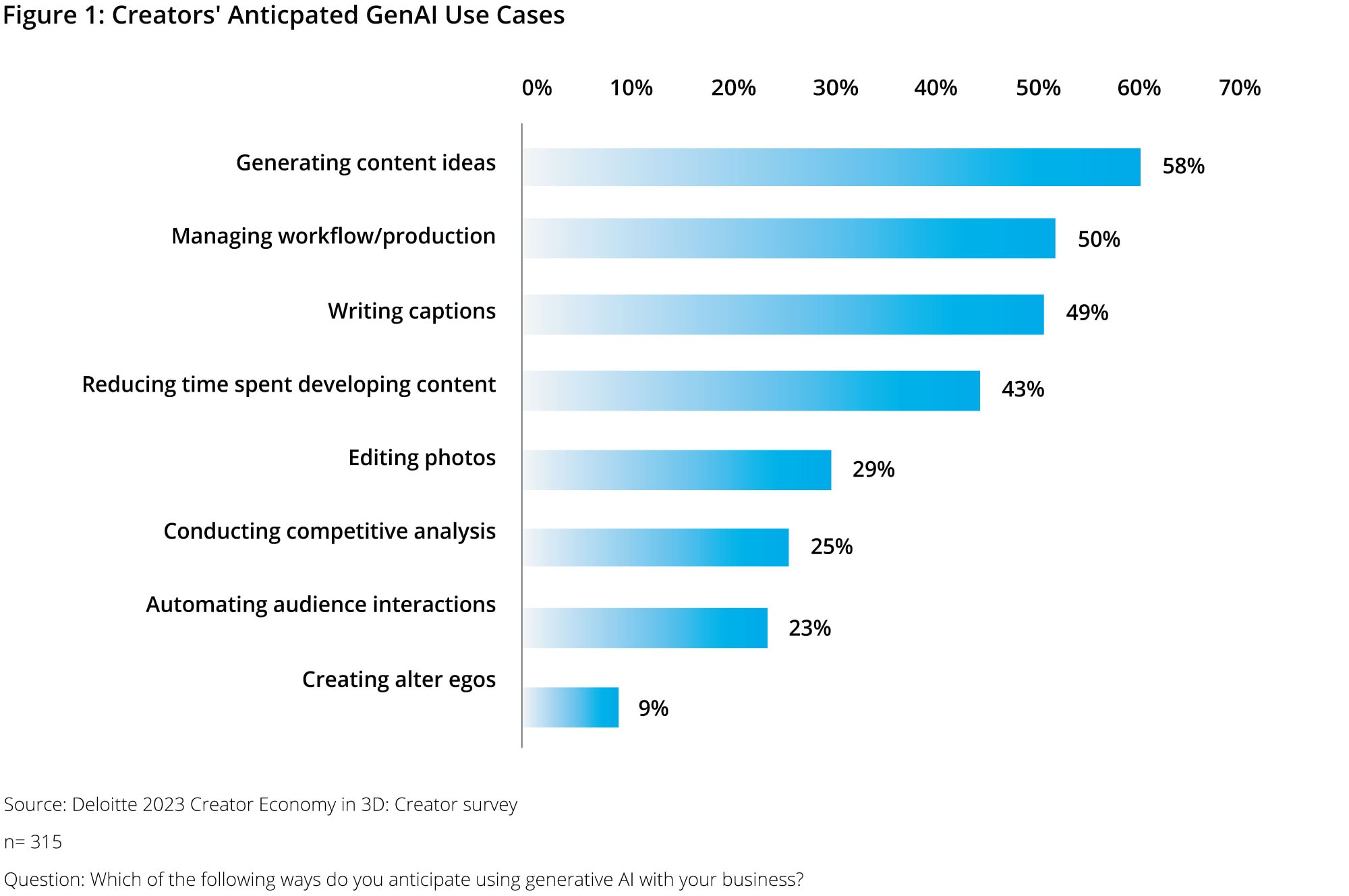GenAI and the Creator Economy: How creators are looking to leverage AI and what this means for brands has been saved

Perspectives
GenAI and the Creator Economy: How creators are looking to leverage AI and what this means for brands
Content Creators and GenAI
Nearly every company is either currently working on or planning to use generative AI, but they’re not alone. 62% of creators also anticipate using generative AI to assist with their business across a variety of use cases over the next year.¹ This report sheds light on where creators anticipate they’ll use GenAI, what these use cases mean for creators, and the lessons brands can take away to optimize their own operational efficiency.
GenAI is a transformative technology with massive implications for how brands operate— and brands are affirming its importance through their adoption rates. Our 2023 Creator Economy in 3D survey found that 94% of brands working with content creators are either currently using or have plans to use generative AI. Of those brands—55% are already using generative AI in some capacity and the other 39% have plans to use within the next year.2
What’s less clear is how GenAI comes into play with the Creator Economy. Like brands, creators are testing GenAI to assist with their business, using it for tasks like concepting, production management, content creation including caption generation, personalization and more. In fact, around 3 in 5 creators anticipate using generative AI to assist with their business across a variety of use cases.3 To understand how creators are thinking about GenAI in their field, we surveyed over 500 creators on which use cases they anticipated adopting (see Figure 1).

Creators see generative AI primarily as a tool for creative assistance and workflow optimization – and brands should look to creators for lessons
Among our surveyed creators that anticipate using GenAI, the top anticipated use case was as a creative assistant—specifically for generating new content ideas. Content creators are often the trailblazers for creativity in the social space – here again GenAI is no exception. Creators present an ever-evolving landscape of use cases for brands to draw from, and brands should apply learnings to their own approach based on how creators are leading the way in this space. Brainstorming can be one of the easiest immediate entry points for anyone looking to engage GenAI, as many tools enable automated mind-mapping, logic charts, or other organizational charts. More complex practices could include prompting content ideas based on trending topics, user preferences and historical data—or monitoring social media trends in real-time to provide insights on emerging topics, hashtags, or challenges that provide creators with further direction.
The second highest set of use cases creators are anticipating for GenAI all relate to streamlining content production—whether through managing their workflow, writing captions, or reducing their overall time developing content. As many creators are often one-person operations, GenAI can offer creators an opportunity to streamline their business and let them focus on the creative side their followers go to them for in the first place. As GenAI could lead to shorter lead times for creators to deliver on brand partnerships, brands may begin to push their own internal and external creative teams to follow-suit.
GenAI for alter egos and automating interactions remain rare—but keep an eye on how they may change the creator landscape
At the bottom of the anticipated GenAI use case spectrum, we see some creators who anticipate leveraging GenAI to diversify their income potential, whether through automating audience interactions (23%) or using GenAI to develop alter egos and personas (9% of respondents). These types of use cases could enable creators to enhance their revenue streams without the need to be behind (or in front of) the camera and open up a new frontier of audience engagement.
Brands will likely want to keep a close eye on these use cases to see how they play out in the creator space, but they also challenge some the foundational appeal of creators to their audiences: authenticity. Deloitte’s research found that a shared identity with a creator was a driving force in building consumer trust4, and it is unclear how automating engagement through GenAI may alter that equation. These use cases may serve a different set of objectives or require a different set of engagement strategies.
Recommendations
Look to creators to sharpen your brand’s own approach to creative ideation with GenAI.
Creators are often the creative trailblazers of social media, and brands should look to how creators are paving the way for how GenAI can assist with ideation and creative assistance. For instance, having a quick-turn creative process in place for reactive content development could enable a more rapid response to viral moments or news events. Brands should look to the creator landscape but can also tap directly into their own creator partnerships for guidance.
Take lessons from creator applications of workflow to scale your own partnerships.
Often a solo operation, content creators are looking to GenAI for a variety of workflow optimization use cases, and brands can apply these tools to optimize and scale their own content development operations. Brands can use generative AI in ways to make content more accessible or engaging to a broader audience via automating tasks like caption generation and personalization at scale—both critical tasks that can maximize content appeal and reach and can be tedious when done manually. Using generative AI can ease workload on marketing teams, complementing teams’ existing skills and freeing team members time for more high impact tasks.
Keep an eye on persona and engagement automation.
While it is too early to tell how successful these use cases may be, or how they will interact with the overall creator landscape, brands should nevertheless keep close tabs on how they develop. While not a consistent practice currently, potential future strategies could include partnering with these creators’ “alter egos”. While the scaling potential of automating personalities and audience interactions is promising, brands should consider the risks of running against the underlying appeal of authenticity that creators offer their audience.
Endnotes
1 Deloitte 2023 Creator Economy in 3D: Consumer study
2 Deloitte 2023 Creator Economy in 3D: Brand study
3 Deloitte 2023 Creator Economy in 3D: Creator study
4 Deloitte 2023 Creator Economy in 3D: Consumer study
Recommendations
The Creator Economy in 3D
This report covers how the content creator economy is changing consumer engagement with brands, media, and buying channels.
Creator Economy in 3D: The platform’s place in a shifting media landscape
Consumers and social media






